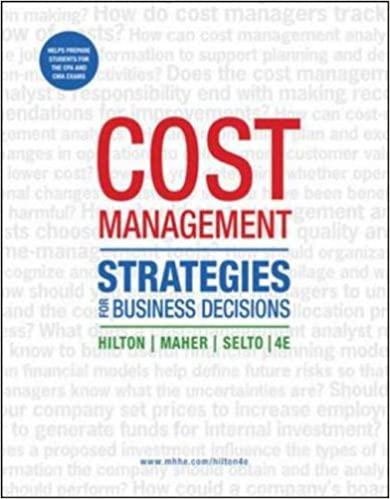Ag-Coop is a large farm cooperative with a number of agriculture-related manufacturing and service divisions. As a
Question:
Ag-Coop is a large farm cooperative with a number of agriculture-related manufacturing and service divisions. As a cooperative, it pays no federal income taxes. It operates a fertilizer plant, which processes and mixes petrochemical compounds into three brands of agricultural fertilizer: Greenup, Maintane, and Winterizer. The three brands differ with respect to selling price and the proportional content of basic chemicals.
The Fertilizer Manufacturing Division transfers the completed product to the cooperative’s Retail Sales Division at a price based on the cost of each type of fertilizer plus a markup. The Manufacturing Division is completely automated so that the only costs it incurs are for the petrochemical inputs plus automated conversion, which is committed for the coming period. The primary feedstock costs $1.50 per kilogram. Each 1,000 kilograms of feedstock can produce either of the following mixtures of fertilizer:
Output Schedules (in kilograms) A B ERVeSYA I Ob eda aera as teniigenee oartacaieret ater tes Sera ah Sacre ae 500 600 UPTIOC CNA IC Term ean eae marcel emnaere machre wciaerteeoserearacnorotsiceones nn k 300 100 WINTERIZON oo secnSese nirrgicusery ansieareancenus ute naesoaan sanataranman cae 200 300 Production is limited to the monthly capacity of the dehydrator at 750,000 kilowatt-hours. The different chemical makeup of each brand of fertilizer requires different dehydrator use as follows:
Kilowatt-Hour Product Usage per Kilogram GEST ONE AE PIR SEL ade. Ee eee 32 WAlINtAIORA SARE A 2 IEG. na atek a ee teant, 20 WIRTERIZere Aen eotieeh 3S Sen aS a 40 Monthly conversion costs are $81,250. The company is producing according to output schedule A.
Joint-production costs including conversion are allocated to each product on the basis of weight.
The fertilizer is packed into 50-kilogram bags for sale in the cooperative’s retail stores. The Manufacturing Division charges the retail stores its cost plus a markup. The sales price for each product charged by the cooperative’s Retail Sales Division is as follows:
Sales Price per Kilogram GTEC Nannrs acncn teeter ee $10.50 MaIntaneeien a ccusttoa iire ater e 9.00 WiIRTENIZET Reeeee tes Bek, 10.40 Selling expenses are 20 percent of the sales price.
The manager of the Retail Sales Division has complained that the prices charged are excessive and that she would prefer to purchase from another supplier. The Manufacturing Division manager argues that the processing mix was determined based on a careful analysis of the costs of each product compared to the prices charged by the Retail Sales Division.
Required a.
c.
Assume that joint-production costs including conversion are allocated to each product on the basis of weight. What is the cost per kilogram of each product including conversion costs and the feedstock cost of $1.50 per kilogram, given the current production schedule?
Assume that joint-production costs including conversion are allocated to each product on the basis of net realizable value if it is sold through the cooperative’s Retail Sales Division. What is the allocated cost per kilogram of each product, given the current production schedule?
Assume that joint-production costs including conversion are allocated to each product on the basis of weight. Which of the two production schedules, A or B, produces the higher operating profit to the firm as a whole?
Would your answer to requirement
(c) be different if joint-production costs including committed overhead were allocated to each product on the basis of net realizable value? Explain.
Can you recommend an approach to product planning that considers the organization’s overall profitability and avoids the divisional controversy? What are the costs and benefits of your recommended approach
Step by Step Answer:

Cost Management Strategies For Business Decisions
ISBN: 12
4th Edition
Authors: Ronald Hilton, Michael Maher, Frank Selto





